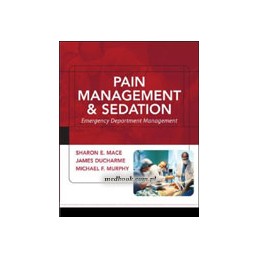- Reduced price

Order to parcel locker

easy pay


 Delivery policy
Delivery policy
Choose Paczkomat Inpost, Orlen Paczka, DHL, DPD or Poczta Polska. Click for more details
 Security policy
Security policy
Pay with a quick bank transfer, payment card or cash on delivery. Click for more details
 Return policy
Return policy
If you are a consumer, you can return the goods within 14 days. Click for more details
DETAILED GUIDANCE ON PAIN RELIEF IN THE ED
This thorough and informative text provides ready, expert answers to both everyday questions and to the often challenging, complex, and diverse issues that arise around pain management and sedation in the emergency department. Written by three leading authorities, Pain Management and Sedation provides in-depth, yet practical and easy-to-find guidance on relieving the complaint that brings more than 50% of patients to emergency care. A groundbreaking work, it is the first text to treat this important subject in depth from the emergency room perspective.
Covering every aspect of the subject, Pain Management and Sedation offers
EXPERT GUIDANCE
Patient assessment protocolsDrug regulationsDrug-seeking patientsLocal and regional anesthesiaConscious sedationDrug therapeutics, with dosage chartsPatients with special considerationsAnxiety reliefNonpharmacologic interventionsLegal and administrative issuesData sheet
1. History/Background
2. Definitions
3. Regulations
4. Documentation/Standardized Forms
5. Quality Improvement/Risk Management
6. Legal Aspects
7. Policies and Procedures
1. Preprocedural PatientAssessment
2. American Society of Anesthesia (ASA) Classifications
3. Pain Scales
4. Equipment
5. Procedural Patient Assessment and Monitoring
a. Airway
b. Respiratory
c. Cardiovascular/Hemodynamics
d. Neurologic
6. Post Procedure Evaluation
a. Discharge Criteria Assessment of Patient Stability
b. Patient Discharge Instructions
1. Cardiovascular
2. Respiratory
3. Central Nervous System
4. Autonomic Nervous System
5. Renal
6. Hepatic
1. Conscious Sedation
2. Pain Management
a. Definition, acute vs chronic
b. Pathophysiology
c. The Drug Seeking Patient
3. Regional Anesthesia
4. Nerve Blocks
5. Local Anesthesia
a. Topicals
1. Vapocoolant sprays
2. Creams:: EMLA, Eutetic, elemax
3. Combination Solutions:: Tac, LET
b. Injectables
1. Amides
2. Esters
3. Long acting vs short acting
4. Others:: Benadryl
c. Iontophoresis (numby)
1. Muscle Relaxants
2. Neuromuscular Blockers
3. Adjunctive Medications
a. Atropine/Glycopyrolate
b. Lidocaine
c. Others
4. Reversal Agents
a. Naloxone/Naltrexone
b. Flumazenil
5. Agents for Conscious Sedation (Sedative Drugs)
a. Propofol
b. Etomide
c. DPT
d. Chloral Hydrate
e. Barbiturates
f. Benzodiazepines
g. Ketamine
6. Pain Medications
a. Opoids
b. Nonsteroidal
c. Acetaminophen
d. Others
7. Anesthetics
a. Inhalant anesthetics
b. Nitrous oxide
1. Devices
a. Transcutaneous Electrical Nerve Stimulation (TENS)
b. Continuous Infusions
2. Palliative Care
3. Pediatrics
a. Pediatrics
b. Neonates
c. Children with Special Health Care Needs
4. Geriatrics
5. The Pregnant Patient
6. Nonpharmacologic Interventions
a. Hypnosis
b. Psychologic Techniques
